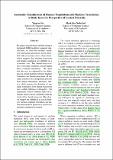Files in this item
Automatic classification of human translation and machine translation : a study from the perspective of lexical diversity
Item metadata
| dc.contributor.author | Fu, Yingxue | |
| dc.contributor.author | Nederhof, Mark Jan | |
| dc.contributor.editor | Bizzoni, Yuri | |
| dc.contributor.editor | Teich, Elke | |
| dc.contributor.editor | España-Bonet, Cristina | |
| dc.contributor.editor | van Genabith, Josef | |
| dc.date.accessioned | 2021-06-03T10:30:14Z | |
| dc.date.available | 2021-06-03T10:30:14Z | |
| dc.date.issued | 2021-05-31 | |
| dc.identifier | 273993683 | |
| dc.identifier | 777591c5-314d-4ecb-be42-2d2ae1d834bc | |
| dc.identifier.citation | Fu , Y & Nederhof , M J 2021 , Automatic classification of human translation and machine translation : a study from the perspective of lexical diversity . in Y Bizzoni , E Teich , C España-Bonet & J van Genabith (eds) , Proceedings for the First Workshop on Modelling Translation : Translatology in the Digital Age . NEALT Proceedings Series , Linkoping University Electronic Press , pp. 91–99 , Workshop on Modelling Translation , Online City , Iceland , 31/05/21 . < https://aclanthology.org/previews/ingest-nodalida/2021.motra-1.10/ > | en |
| dc.identifier.citation | workshop | en |
| dc.identifier.issn | 1650-3686 | |
| dc.identifier.other | ORCID: /0000-0002-1845-6829/work/95041670 | |
| dc.identifier.uri | https://hdl.handle.net/10023/23304 | |
| dc.description.abstract | By using a trigram model and fine-tuning a pretrained BERT model for sequence classification, we show that machine translation and human translation can be classified with an accuracy above chance level, which suggests that machine translation and human translation are different in a systematic way. The classification accuracy of machine translation is much higher than of human translation. We show that this may be explained by the difference in lexical diversity between machine translation and human translation. If machine translation has independent patterns from human translation, automatic metrics which measure the deviation of machine translation from human translation may conflate difference with quality. Our experiment with two different types of automatic metrics shows correlation with the result of the classification task. Therefore, we suggest the difference in lexical diversity between machine translation and human translation be given more attention in machine translation evaluation. | |
| dc.format.extent | 139015 | |
| dc.language.iso | eng | |
| dc.publisher | Linkoping University Electronic Press | |
| dc.relation.ispartof | Proceedings for the First Workshop on Modelling Translation | en |
| dc.relation.ispartofseries | NEALT Proceedings Series | en |
| dc.subject | Q Science (General) | en |
| dc.subject | Artificial Intelligence | en |
| dc.subject | 3rd-DAS | en |
| dc.subject.lcc | Q1 | en |
| dc.title | Automatic classification of human translation and machine translation : a study from the perspective of lexical diversity | en |
| dc.type | Conference item | en |
| dc.contributor.institution | University of St Andrews. School of Computer Science | en |
| dc.identifier.url | https://aclanthology.org/previews/ingest-nodalida/2021.motra-1.10/ | en |
This item appears in the following Collection(s)
Items in the St Andrews Research Repository are protected by copyright, with all rights reserved, unless otherwise indicated.

